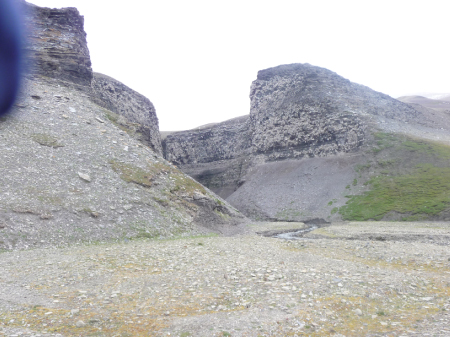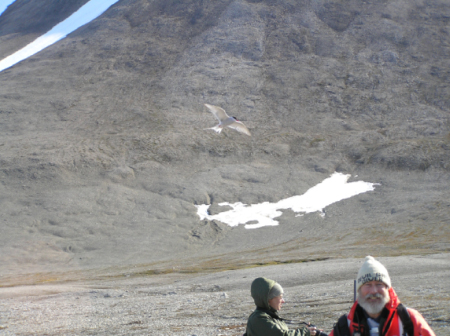Animals of the sky, land, and water
This trip was a good chance to do some birdwatching--birds were plentiful, if not particularly varied.
 |
 |
| One place that we stopped was a kittiwake rookery--they nest in this canyon cut by a glacial river. Pat is glad she was not the naturalist who had to go check here for polar bears! | The noise in the canyon was piercing as the kittiwakes circled around us. It was late in the season so there were not many chicks, although there were plenty of broken shells on the canyon floor. |
 |
 |
| The walls provide good nesting places for the birds and you have to look carefully to distinguish the roosting birds from the rocks. | One guy who had no trouble doing that was the little arctic fox, who made a good living stealing eggs and chicks. We think of them as being white, but they are brown in the summer. |
 |
 |
| Arctic terns, who nest on the ground, have a well-deserved reputation for being fierce defenders of their nests and will dive-bomb anything or anyone that gets too close--even Expedition Leader Tom. |
But some photographers will endure even that to get the shot--not a good idea since it disturbs the birds, which is illegal. |
 |
 |
| A common shorebird that we saw was the purple sandpiper--which isn't purple, at least at this time of year. | We stumbled across a purple sandpiper nest--unlike the tern, the sandpiper didn't attack us but instead ran off and pretended to be injured to draw off us "predators." |
 |
 |
| We didn't see a lot of reindeer on this trip, but those we saw were rather funny-looking, with spindly legs. Chuck said that they must be the source of Santa's "Eight tiny reindeer" because they were so small. |
|
 |
 |
| Weather changed abruptly in this part of the world--in this case, from sleet when we arrived to sudden sunshine, producing a nice rainbow. |
And some days were clear and lovely. |
The Tale of the Whales
Many of the beaches we saw were littered with whale bones and some had remains of whaling stations as well--this used to be a major whaling area. Whaling was easy because the whales lived in the fjords and were easily accessible. The bones were typically 20 feet or more from the shore, but they didn't start out there. Whalers would dismember the carcasses just offshore and dump the remains in the water. But as the ice in Svalbard has melted since the last ice age (accelerated now by global warming), the weight of the ice on the land has decreased and the land has "rebounded" out of the sea. So, ironically, as global warming continues, areas that are uninhabited because they were covered with ice will increase their land area, while heavily-inhabited coastal areas further south will be innundated. |
 |
| This cabin still has remains of the whale-oil rendering facilities. |
|
 |
 |
| The bones stay in good condition because of the dry, cold climate and give some idea of the magnitude of industry that pretty much wiped out the whales. There were no facilities for processing the meat or extracting the oil from bones, so most of the whale was wasted. |
|
 |
|
| In areas that are otherwise quite barren and rocky, plants often spring up around the bones, using the minerals in the bones and the condensation around them to grow. | |



